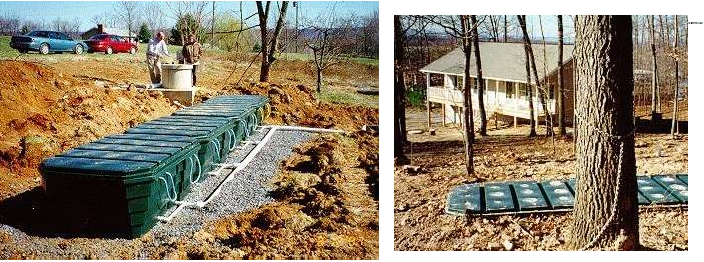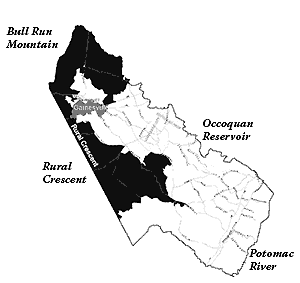"Sewering in the Green"

Alternative Onsite Sewer Systems make parcels suitable for development, even if local jurisdictions block extension of sewer lines to that area
Source: Virginia Department of Health
Often, the first sewers in Virginia were just pipes leading to the nearby rivers. When the solution to pollution was dilution, it was considered appropriate to dump raw sewage into waterways and let Mother Nature clean it up. Natural processes will result in the sewage being converted to carbon dioxide, water, and biomass of bacteria, zooplankton, and phytoplankton in the streams.
If the input of sewage is tiny compared to the volume of the stream, then the environmental impact may be acceptable. (Managers of public swimming pools know that they have to keep adding fresh water to the pool, far more than just what's lost to evaporation, to dilute the "Number 1" contributions from little children...)
Initially, small treatment plants ("package plants") were built for different sections of a city as it grew, especially as subdivisions were developed. When water pollution laws required more than primary treatment (settling of the solids), construction costs escalated. There was economy of scale in building a few giant facilities rather than maintaining numerous small ones, and in the last 30 years sewage treatment has become hifghly centralized.
Virginia counties and cities have limited rights in controlling the use of land. By refusing to build sewer lines into rural areas, however, planners and elected officials can concentrate development in those areas where there are adequate public facilities - especially sewer and water. Limiting access to waste treatment facilities is a back-door form of zoning and growth control.
"Sewering in the green" is a reference to building new sewer lines into low-density or undeveloped areas, thus greatly enhancing the value of the private property in such watersheds. Already urbanized areas and rural areas don't face this issue. In suburban areas, however, construction of new/expanded sewer and water lines, or approval of new "package plants" for new subdivisions without a connection to other sewers, can be critical to developers. Environmentalists are constantly watching the political contributions to county supervisors, recognizing that the investments in public utilities are political decisions that can bring great benefits to some constituents.
Most urban areas have connected toilets to sewer systems, and treate human waste to meet water quality standards. Rural areas rely upon individual septic systems to process sewage. Cesspools (open pits into which waste drained and evaporated) are now rare, but Virginia still has thousands of outhouses - and a few valleys where "straight pipes" are used to carry waste directly from a house to a stream.
What we flush down the toilet in most rural areas goes into a septic tanks, where heavy items settle out and anaerobic bacteria decompose the organic materials. Fluid at the top of the tank then flows through pipes in the soil, where aerobic microbes complete the decomposition into harmless carbon dioxide and water. Erma Bombeck once titled a book, "The Grass Is Always Greener Over the Septic Tank," and those nitrates do fertilize the roots from below.
(NOTE: Pipes can break, due to a shovel or stake pushed into the ground without care. After a wet weekend, a neighbor's horse once got into my "pasture." I thought of it as a back yard, but grass is grass to a hungry horse. The heavy horse's hoof sank into the mud and cracked the drainage pipe. The result - a steady stream of septic drainage flowed from my drainage field into the neighbor's back yard, until on a warm day we discovered the problem.)
The pipes in a drainage field can become clogged with particles flushed down the toilet. Once a drainage field becomes clogged with nutrients and the soil can no longer support the microbes that naturally convert sewage, the field no longer "percs" (percolates) and is described as a "failed" septic system. Without the right soil particle sizes and chemistry, septic fluid will flow out of the tiny holes in the drainfield pipes too fast for the soil bacteria to process it. When the septic effluent adds excessive nitrates and other nutrients to the atmosphere in the local area... you'll smell it.

a portion of Prince William County is zoned for low-density (1 house/10 acres) development, and the "Rural Crescent" is relatively far from the roads/rail network for commuters to reach job centers in Tysons/DC
Source: Prince William Conservation Alliance
One reason for expanding sewage lines into the periphery of an urban area is to handle the increasing concentration of waste. A townhome develpment with 20 dwelling units/acre will create far too much sewage for even a huge septic tank, so a small package treatment plant or a connection to a giant centralized sewage treatment plant is needed.
Suburbanizing counties and cities with remaining rural areas rely upon the control of sewage lines to steer housing growth towards some areas,and away from others. State and county land use planning laws in Virginia often lack teeth, since many properties have already been zoned for more development than the infrastructure or environment can withstand. The elected officials can't "downzone" very often, reducing allowed densities - but the water pollution laws allow the counties and cities to shape the pattern of growth by limiting access to sewage treatment facilities.
Waste Management in Virginia
Virginia Places

